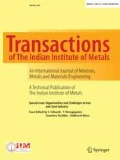Abstract
The phenomenology of multicomponent diffusion studies was carried out in the IN718/BNi-2/AISI 316L joined couple at bonding temperature 1050 °C for bonding time 45 min. This study has been employed for the determination of interdiffusion fluxes, zero-flux planes and chemical potential gradient for multicomponent system of IN718/BNi-2/316L. The chemical composition of phases in the diffusion zone were analyzed by energy-dispersive spectroscopy, and the mobility parameter was extracted from Thermo-Calc software, DICTRA module. Interdiffusion fluxes of individual components, e.g., Ni, Cr, Fe, Si, B, Ti and Nb, were determined directly from the experimental concentration profiles and were examined in the light of diffusional interactions. The calculated flux result revealed that boron diffusion toward IN718 alloy was more than 316L alloy in the presence of other alloying elements. In addition, this observation was evaluated thermodynamically using the chemical potential gradient that was calculated for each component. The chemical potential results showed that the chemical potential gradient of boron in the presence IN718 elements was lower than chemical potential gradient of boron in the presence 316L elements.












Similar content being viewed by others
Notes
Transient Liquid Phase bonding.
Diffusion Affected Zone
References
Zhang W, Zhang L, Du Y, Liu S, and Tang C, Int J Mater Res105 (2014) 13.
Devendranath Ramkumar K et al. Metallogr Microstruct Anal4 (2015) 305.
Locci I E, Bowman C L, and Gabb T P, Development of High Temperature Dissimilar Joint Technology for Fission Surface Power Systems (2009).
Cortés R, Rodríguez N K, Ambriz R R, López V H, Ruiz A, Jaramillo D, Mater Sci Eng A745 (2018) 20.
Carroll B E et al, Acta Mater108 (2016) 46.
Anitha P, Majumder M C, Saravanan V, and Rajakumar S, Metallogr Microstruct Anal7 (2018) 277.
Pouranvari M, Ekrami A, and Kokabi A H, Weld Res93 (2014).
Shamsabadi A Y, and Bakhtiari R, J Alloys Compd685 (2016) 896.
Pouranvari M, Ekrami A, and Kokabi A H, J Alloys Compd563 (2013) 143.
Paul A, Laurila T, Vuorinen V, and Divinski S V, Thermodynamics, Diffusion and the Kirkendall Effect in Solids (2014).
Liu Y, Long Z, Du Y, Sheng G, Wang J, and Zhang L, Calphad36 (2012) 110.
Dayananda M A, Metall Trans A14 (1983) 1851.
Borgenstam A, Höglund L, Ågren J, and Engström A, J Phase Equilib21 (2000) 269.
Author information
Authors and Affiliations
Corresponding author
Ethics declarations
Conflict of interest
The authors declare that they have no conflict of interest.
Additional information
Publisher's Note
Springer Nature remains neutral with regard to jurisdictional claims in published maps and institutional affiliations.
Rights and permissions
About this article
Cite this article
Salmaliyan, M., Shamanian, M. & Shafyei, A. Multicomponent Diffusion Studies in Selected High Temperature for IN718/BNi-2/316L Diffusion Couple. Trans Indian Inst Met 73, 1319–1331 (2020). https://doi.org/10.1007/s12666-020-01977-x
Received:
Accepted:
Published:
Issue Date:
DOI: https://doi.org/10.1007/s12666-020-01977-x




